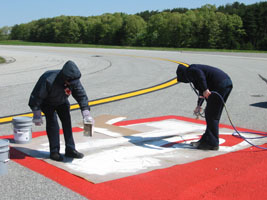 What is lead-based paint?
What is lead-based paint?
Lead is a highly toxic metal that was used for many years in paints. Lead-based paints are highly durable. In general, lead-based paint in good condition is not a hazard. However, when lead-based paint deteriorates or is disturbed in any way, lead can be released to the environment and pose human health risks. Common exposure pathways include contact with peeling, chipping, chalking, or cracking lead-based paint and contact with lead contaminated dust.
Lead dust can form during renovation or demolition activities when lead-based paint is dry scraped, dry sanded, or heated. Dust also forms when painted surfaces bump or rub together. Lead chips and dust can get on surfaces and objects that people touch. Settled lead dust can re-enter the air when people vacuum, sweep, or walk through it.
Lead exposure can cause a wide array of health problems, including brain damage, reproductive problems, kidney failure, and death.
Although lead-based paint is no longer used in residential settings (its use was banned in housing in 1978), it is still allowed in industrial settings such as at BWI Marshall or Martin State Airports. Lead-based paint may still be used in non-residential applications that require superior corrosion protection or durability. In addition, lead-based paint may be found on structures that have since been re-painted (painted over) with non-lead paint. For example, lead-based paint may be present on outdoor painted surfaces such as curbs and road or runway markings.
These painted surfaces are a hazard only if disturbed in a way that produces dust or paint fragments. Once the surface is disturbed, the waste that is produced (dust, paint chips) is considered hazardous and must be disposed of properly.
MDOT MAA no longer uses lead-based paint; however, there are a number of older buildings and structures that tenants may use that may have lead-based paint coated components. In 2003, MDOT MAA surveyed all accessible painted surfaces in and on MDOT MAA-owned buildings at BWI Marshall and Martin State Airports for lead-based paint using an x-ray fluorescence device. In those areas that are leased but not tenant owned, MDOT MAA assures that the proper precautions or management practices were undertaken to minimize exposure to lead-based paint.
Tenant-owned facilities, buildings, and equipment may contain surfaces painted with lead-based paint. Tenants are responsible for meeting the applicable environmental regulations and requirements in these areas.
MDOT MAA works to protect employees from lead-based paint hazards by:
Making sure that renovation or demolition work involving lead-based paint is performed by a certified contractor. Contractor personnel must take specific measures to avoid spreading lead-based paint dust, paint, or residue. Contractor personnel must post signs to warn others to avoid disturbing the lead-based paint work area.
Preparing specifications for work involving lead-based paint and monitoring these activities to make sure the specifications are met.
Making sure that lead-based paint contractors properly dispose of all lead-based paint waste.
Managers and supervisors can help protect their employees from lead-based paint hazards by:
- Knowing what lead-based paint, if any, is present in areas of your responsibility.
- Contact the Environmental Compliance Section to review the MDOT MAA Lead Location Manual that lists known lead-based paint surfaces.
- Making sure employees are aware of any lead-based paint areas in their workspace and know not to disturb these painted surfaces in ways that would release paint dust or particles.
- Making sure that any projects that would involve disturbing lead-based paint are properly planned.
- Informing employees about any lead-based paint projects in their work areas, and making sure that warning signs are properly posted and observed.
When performing renovation work on structures with known or suspected lead-based paint, tenants must ensure that the contractors are certified by the State of Maryland to abate the lead-based paint in a safe manner, according to all federal and state requirements. A list of certified contractors can be obtained from MDE’s Lead Poisoning Prevention Program office or by visiting the following link on the MDE web page.
In addition, tenants must ensure that all abatement work is being performed in accordance with all state and federal lead-based paint regulations. If you have hired a contractor to do this, one way to assure this occurs is by including specific language in your contracts. The contracts should include detailed information on lead-based paint removal, cleanup, and disposal procedures in accordance with all applicable regulations.
Finally, you must monitor the progress of the abatement throughout the renovation process, and ensure that all safety and regulatory procedures are being followed according your specifications.
Current state and federal lead-based paint regulations are primarily designed to protect children in residential structures and workers in specific construction/industrial industries. Lead-related regulations of concern to tenants who own buildings at BWI Marshall and Martin State Airports apply to 1) lead abatement activities and 2) disposal of lead-containing materials. These activities must be performed by state certified personnel, and tenant staff should monitor these activities to ensure work is performed in compliance with the regulations.
Maryland’s regulations relating to lead-based paint generally follow the federal requirements, with some additional, more stringent, state requirements. Applicable regulations include:
- COMAR 26.16.01.05 – LEAD-BASED PAINT abatement training
- COMAR 26.02.07.03 – LEAD-BASED PAINT abatement procedures
- COMAR 26.13.02.05 – Disposal of controlled hazardous substances
- 29 CFR 1910.1025(n) – OSHA exposure record keeping
- 29 CFR 1910.1025(l)(1) – OSHA lead training
- 29 CFR 1926.62 – OSHA construction industry employment standards
- 40 CFR 745.227 – TSCA exposure record keeping
